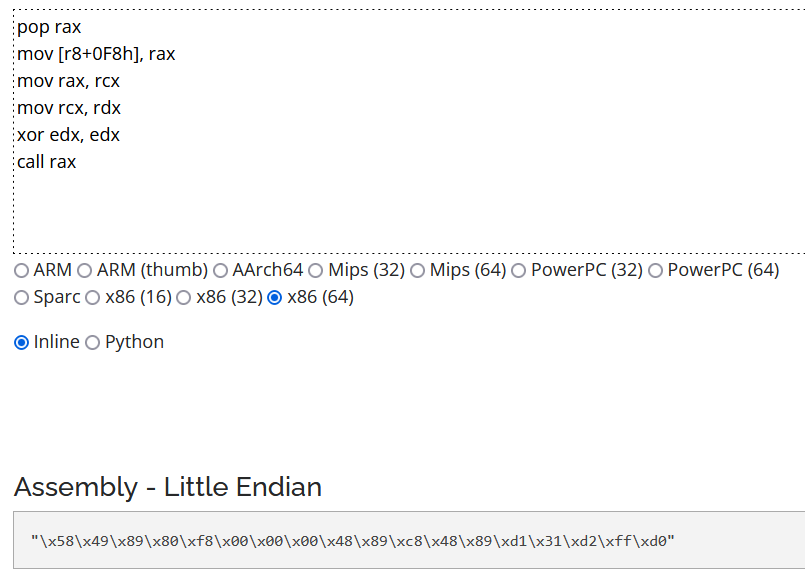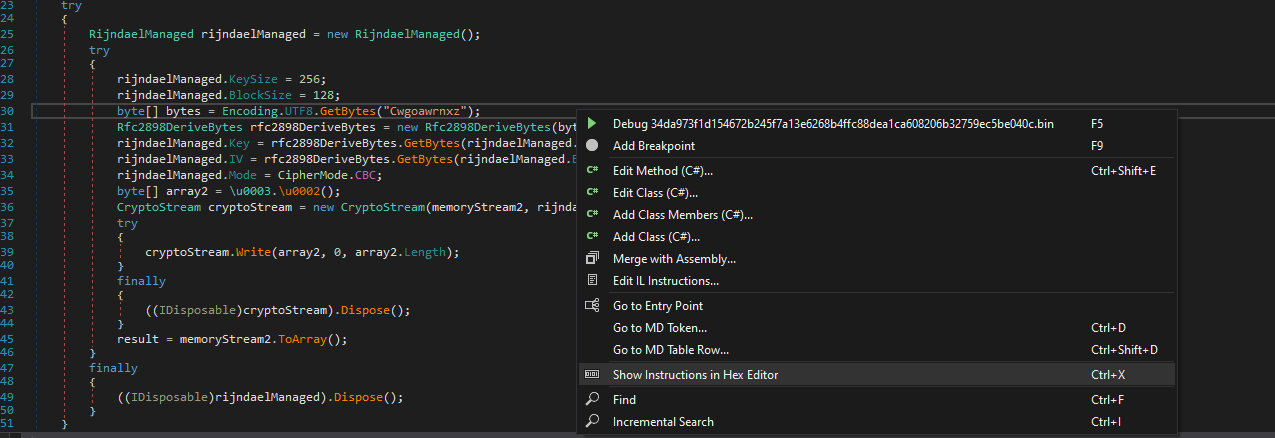| \t |
Tab (HT, TAB) |
| \n |
New line (LF, NL) |
| \r |
Return (CR) |
| \xnn |
Character whose ordinal number is the given hexadecimal number |
| \w |
Match a word character (alphanumeric letter) |
| \W |
Match a non-word character |
| \s |
Match a whitespace character |
| \S |
Match a non-whitespace character |
| \d |
Match a decimal digit character |
| \D |
Match a non-digit character |
##### The regex must be declared with a couple of ```/``` like the following exemple :
```
$s = /{host : \w{3,16},os : \w{3,9}, av : [a-zA-Z]{3,32}}}/
```
### Hexadecimal sequences (traits)
##### In some cases, it's necessary to detect similiar partitions of asm codes or which may present several alternatives.
##### First, this possible to use wildcard ```?``` for specify portions of hexadecimal values that can vary and should match with anything.
##### As example, we can see that it's possible to put wildcards on part of a hex value :
```
$str_hex = { FA ?1 ?? 7? 34 }
```
##### Another highlight is the ability to jump groups of hex values in specifying the length ranges, this particularly useful for joining parts of reused codes, since the compliers each have different in terms of optimization or way of compiling the code, the opcodes will be different and as a result the hexadecimal sequences (traits) will have more or less important disparities even if we have the same original code.
##### In this example, we can see two similiar parts of codes ```FA 21 44``` and ```77 98 34``` that have a different sequence of hex code inside, for this, we chose to specify the jump interval with the smallest and largest jump value, i.e. 2 and 4 ([min-max]).
```
FA 21 44 [2-4] 77 98 34
FA 21 44 XX XX 77 98 34
FA 21 44 YY YY YY YY 77 98 34
```
##### Note : Since YARA 2, this possible to use ```infinite``` range inno specify the min or/and max range ([-], [x-],[-y]), the parser will continue until this match on the next block of the identifier. This method is interesting the case of the attacker insert lot of spaces or junk code but this consume lot of ressources and aren't optimized in the fast approach for real time.
##### Another point of interest is the ability to switch with mutliple cases for like on a regex aproach in using multiple jumps :
##### Here, we have an attacker which use as persistence folder a set of keywords ```ìnstall```,```word2021``` and ```excel2021``` in the ```system folder```, we can concatenate with a jump the commun part ```\xxxx2021``` ( need to have hex code in the both side of the jump, explains why use ```\```) and push the different cases in the switch state with different "OR" conditions.

 ##### This allows the following metacharacters :
##### This allows the following metacharacters :
 ##### Once the pointer go to location the code in the file, you can copy/paste the hex sequences with the same structure of code of the different payload for make a hex sequence with jump or wildcard of the different value of opcodes due to different compiler used for built the payloads (different compiler have their own optimisation operations when there translate the source code to asm code).
##### Once the pointer go to location the code in the file, you can copy/paste the hex sequences with the same structure of code of the different payload for make a hex sequence with jump or wildcard of the different value of opcodes due to different compiler used for built the payloads (different compiler have their own optimisation operations when there translate the source code to asm code).
 #### Hunting ATM malwares
##### ATMs need XFS middleware that provides client-server architecture for financial applications on Microsoft Windows platform and allow to communicate with service providers via the XFS Manager using a set of API.
##### These largely check for the presence of ```MSXFS.dll``` and instructions to devices via ```WFSExecute``` or lock/open with ```WFSLock/WFSOpen```.
##### Thus, searching via these strings (in ascii, base64...) can be a good start for the search for new ATM malware, it should not however be forgotten that these strings can also be legitimate and be the MSXFS dll used in the ATM (it has already been noted to me that these legitimate dlls had been submitted to Virustotal/Hybrid Analysis).
#### Hunting ATM malwares
##### ATMs need XFS middleware that provides client-server architecture for financial applications on Microsoft Windows platform and allow to communicate with service providers via the XFS Manager using a set of API.
##### These largely check for the presence of ```MSXFS.dll``` and instructions to devices via ```WFSExecute``` or lock/open with ```WFSLock/WFSOpen```.
##### Thus, searching via these strings (in ascii, base64...) can be a good start for the search for new ATM malware, it should not however be forgotten that these strings can also be legitimate and be the MSXFS dll used in the ATM (it has already been noted to me that these legitimate dlls had been submitted to Virustotal/Hybrid Analysis).

